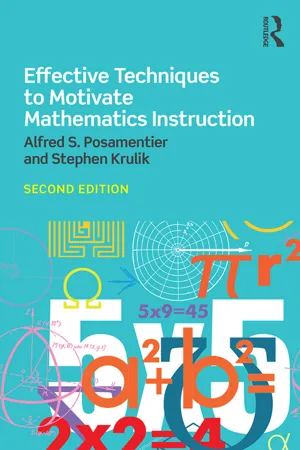
Effective Techniques to Motivate Mathematics Instruction
- 176 pages
- English
- ePUB (mobile friendly)
- Available on iOS & Android
Effective Techniques to Motivate Mathematics Instruction
About this book
Effective Techniques to Motivate Mathematics Instruction offers pre-and in-service teachers best practices and techniques that can be used to motivate students in the first few minutes of any lesson in mathematics. Veteran teacher educators Posamentier and Krulik show how a bit of creativity and planning up front pays back by enabling a successful lesson on even the most challenging mathematics topic. Organized around nine different motivational techniques, each chapter includes a variety of illustrative examples of how the technique may be applied. Designed to complement any methods textbook, this practical, accessible guide helps future math teachers ease the transition from successful student to successful teacher by developing the tools needed to create motivational introductions in their classes.
Frequently asked questions
- Essential is ideal for learners and professionals who enjoy exploring a wide range of subjects. Access the Essential Library with 800,000+ trusted titles and best-sellers across business, personal growth, and the humanities. Includes unlimited reading time and Standard Read Aloud voice.
- Complete: Perfect for advanced learners and researchers needing full, unrestricted access. Unlock 1.4M+ books across hundreds of subjects, including academic and specialized titles. The Complete Plan also includes advanced features like Premium Read Aloud and Research Assistant.
Please note we cannot support devices running on iOS 13 and Android 7 or earlier. Learn more about using the app.
Information
1
Indicate a Void in Students’ Knowledge
Topic: The Introductory Lesson on the Tangent Ratio
Materials or Equipment Needed
Implementation of the Motivation Strategy






Topic: Special Quadrilaterals
Materials or Equipment Needed
Table of contents
- Cover
- Title
- Copyright
- Dedication
- Contents
- Introduction
- The Art of Motivating Students for Mathematics Instruction
- 1 Indicate a Void in Students’ Knowledge
- 2 Discover a Pattern
- 3 Present a Challenge
- 4 Entice the Class with a “Gee-whiz” Amazing Mathematical Result
- 5 Indicate the Usefulness of a Topic
- 6 Use Recreational Mathematics
- 7 Tell a Pertinent Story
- 8 Get Students Actively Involved in Justifying Mathematical Curiosities
- 9 Employ Teacher-Made or Commercially Prepared Materials
- 10 Using Technology to Motivate Mathematical Relationships
- 11 Using Practical Problems to Motivate Instruction
- Index